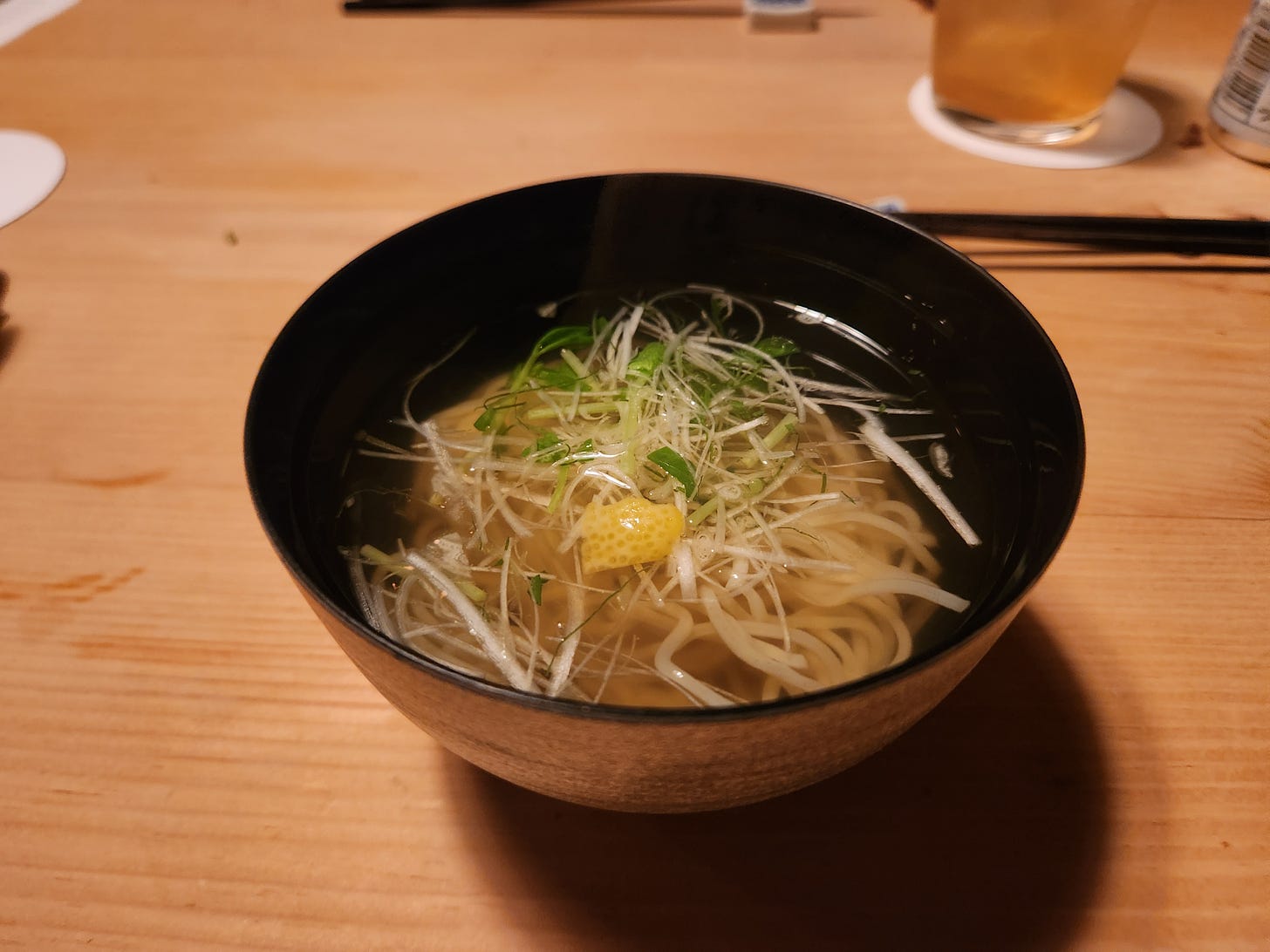In an unexpected turn of events, we ended up with a booking for an Izakaya called “Eat” in Roppongi. We were originally supposed to meet at another restaurant, but one particularly lazy friend didn’t want to stray too far from where he was staying, so we decided to move the venue closer to him instead.
To build an appetite, a friend and I walked from Ginza to Roppongi, about a 90 minute walk, and as fall was just setting it, a fairly pleasant walk at that. We arrived a little early and took our positions at a tiny three seater bar with some highballs while we waited for the rest of our friends to arrive.
As another friend arrived, we were escorted into the only table set around an open kitchen with primarily counter seating. Fortunately for us, there was a table large enough for our table for four, but the backside of the table was inside the kitchen, so two of us ended sitting on the inside of the counters with the chefs hurriedly passing behind us throughout the night.
We ordered a few appetizers and waited for the last lazy friend to arrive.
A few orders of wagyu meatballs, done in a very Italian style. Rich, and fatty in a thick tomato sauce with shaved parmesan and dried oregano on top.
Wagyu dumplings, done in a very Chinese style, in a soy sauce and vinegar sauce, with some green onion and microgreens on top.
Once the last friend arrived, we ordered the omakase, and we were off to the races.
First, a very neat salad, with some vegetables and a really unique Japanese vegetable that looked like it had droplets of water on it. Turns out it’s called “Tsuburina”, a succulent hydroponically grown under very specific conditions to enhance the appearance of the water droplets. The vegetables were served with a tangy dip that was difficult to recognize.
Next, thin slices of rare wagyu that was seared around its exterior on a thin potato cracker topped with caviar and gold flakes. The caviar adding a bit of brininess to cut through the rich wagyu.
Next, the beginning of the yakitori courses, two slices of wagyu strip steak, grilled to a crispy exterior with a tender, juicy interior. As with all wagyu, just immensely well marbled, with the fat adding flavour and juiciness to the meat.
While not impressive looking, this half a shitake mushroom was just oozing with so much liquid and every bite released more of the umami mushroom juice. There was so much liquid trapped in this mushroom that you can see it pooling on the lip of the mushroom even before we bit in. Amazing!
A consistent favourite of mine - chicken cartilage on a skewer. Definitely a texture food, meaty with a bit of crunch and springiness.
I couldn’t tell exactly what cut this was, but it was absolutely delicious. Perfectly seared on the outside, soft and juicy on the inside.
Beef tongue with a healthy pile of green onion and garlic. Really well done. Tongue is always a little tough, but thin slices seared briefly on the grill with the garlic and spring onion as a contrast worked really well together.
The final skewer - a thin slice of beef, rolled around garlic shoots and grilled, served with the same tangy dipping sauce as the salad at the beginning of the omakase.
We were then each handed a wagyu and uni handroll, with a very generous helping of uni, sauced with a slightly sweet and umami eel sauce. Two mouthfuls of umami richness.
The next course had a variety of dishes - a small bowl of grilled gingko nuts, an amazing chicken liver parfait, served between two crispy rice crackers, and avocado and bonito stock jelly topped with dried seaweed. All three were absolute hits - rich, nutty, earthiness from the gingko nuts, perfect contrast between the rich, buttery chicken parfait and the crisp, light rice crackers, and rich mouthfeel from the bonito jelly with some buttery avocado and a bit of texture and some chewiness from the seaweed.
Nearing the end of our meal, we were given a piping hot bowl of ramen in rich chicken stock, topped with some microgreens, shaved green onion and yuzu peel. Light and intensely flavourful.
Dessert was a citrusy yuzu sorbet, a small piece of melon, and half a Shine Muscat grape, a very unique varietal of grape developed in Japan after a 30 year development process. Absolutely massive in size, super firm with a crisp skin and juicy interior bursting in your mouth, these grapes are well worth the money and as different as can be from the green seedless grapes often found in grocery stores.
All in all, Eat is a pretty good meal with friends in a neighborhood izakaya. A decent value, but not particularly exceptional in any way. Given the huge variety of amazing restaurants in Japan, probably not a place I would return to.
Total damage: 18k JPY/head





















